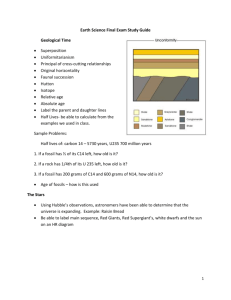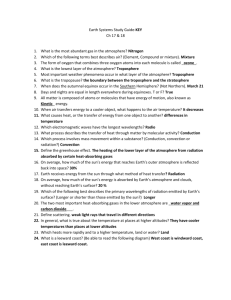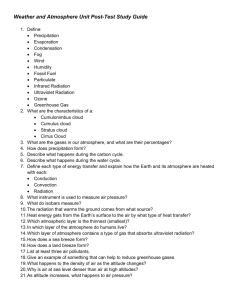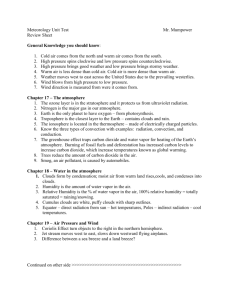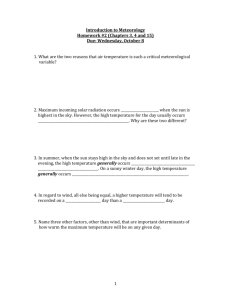01 Meteorology Nov 5
advertisement
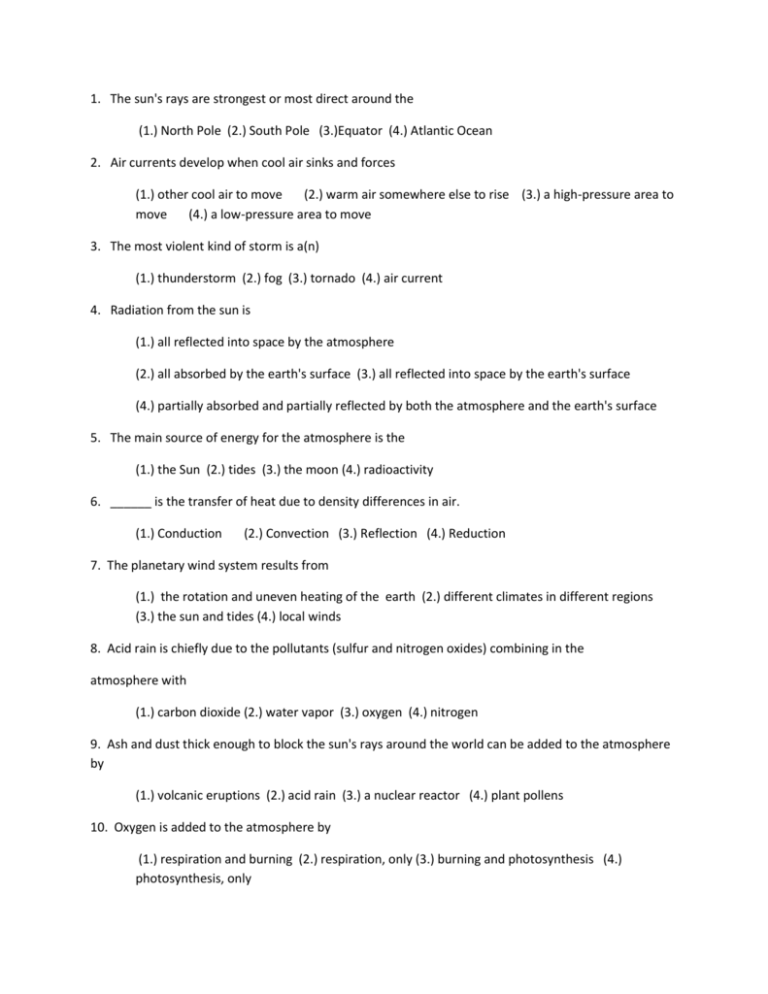
1. The sun's rays are strongest or most direct around the (1.) North Pole (2.) South Pole (3.)Equator (4.) Atlantic Ocean 2. Air currents develop when cool air sinks and forces (1.) other cool air to move (2.) warm air somewhere else to rise (3.) a high-pressure area to move (4.) a low-pressure area to move 3. The most violent kind of storm is a(n) (1.) thunderstorm (2.) fog (3.) tornado (4.) air current 4. Radiation from the sun is (1.) all reflected into space by the atmosphere (2.) all absorbed by the earth's surface (3.) all reflected into space by the earth's surface (4.) partially absorbed and partially reflected by both the atmosphere and the earth's surface 5. The main source of energy for the atmosphere is the (1.) the Sun (2.) tides (3.) the moon (4.) radioactivity 6. ______ is the transfer of heat due to density differences in air. (1.) Conduction (2.) Convection (3.) Reflection (4.) Reduction 7. The planetary wind system results from (1.) the rotation and uneven heating of the earth (2.) different climates in different regions (3.) the sun and tides (4.) local winds 8. Acid rain is chiefly due to the pollutants (sulfur and nitrogen oxides) combining in the atmosphere with (1.) carbon dioxide (2.) water vapor (3.) oxygen (4.) nitrogen 9. Ash and dust thick enough to block the sun's rays around the world can be added to the atmosphere by (1.) volcanic eruptions (2.) acid rain (3.) a nuclear reactor (4.) plant pollens 10. Oxygen is added to the atmosphere by (1.) respiration and burning (2.) respiration, only (3.) burning and photosynthesis (4.) photosynthesis, only 11. The ozone layer absorbs (1.) smog (2.) microwaves (3.) ultraviolet radiation (4.) infrared radiation 12. The atmosphere is made up mainly of (1.) nitrogen and carbon dioxide (2.) nitrogen and water vapor (3.) nitrogen and oxygen (4.) oxygen and argon 13. A barometer is an instrument that can be used to measure (1.) humidity (2.) air pressure (3.) temperature (4.) cloudiness 14. Which of the following statements about burning is FALSE? (1.) It adds oxygen to the atmosphere. (2.) It adds carbon dioxide to the atmosphere. (3.) It is the major source of air pollutants. (4.) It removes oxygen from the atmosphere. 15. Cool, dry weather is usually accompanied by high relative humidity (4.) precipitation (1.) low air pressure (2.) high air pressure (3.) 16. A drop in air pressure usually indicates that the (1.) approaching weather is cool and dry (2.) weather will remain unchanged (3.) approaching weather is cloudy or rainy (4.) air temperature is falling 17. With decreasing air pressure, air temperature usually (1.) remains the same (2.) decreases (3.) increases 18. A wind that comes from the east is a(n) (1.) east wind (2.) west wind (3.) south wind (4.) north wind 19. Wind speeds are affected by (1.) ocean waves (2.) relative humidity (3.) differences in air pressure from one place to another (4.) cloud types 20. Precipitation occurs when (1.) air pressure rises (2.) water drops in clouds grow large enough to fall (3.) there are southwest winds (4.) an air mass is in place 21. The amount of water vapor in the air is described in terms of 1.) relative humidity (2.) cloud cover (3.) atmospheric pressure (4.) temperature 22. Which is NOT used in weather prediction? (1.) weather maps (2.) radar (3.) satellite photographs (4.) air pollution levels 23. High pressure areas generally move across the United States from (1.) north to south (2.) west to east (3.) east to west (4.) south to north 24. The temperature and moisture of an air mass are determined by (1.) its size and shape (2.) its rate of movement direction of movement (3.) the area over which it is formed (4.) its 25. The boundary between two air masses is a(n) (1.) high-pressure area (2.) climate (3.) atmosphere (4.) front 26. The wind direction in a high pressure area is (1.) north to south (2.) east to west (3.) clockwise (4.) counterclockwise 27. Clear, cool weather is generally found (1.) in high pressure areas (2.) in low pressure areas (3.) at fronts (4.) in areas with no wind 28. Two forms of precipitation are (1.) rain and snow (2.) wind and sun (3.) wind and rain (4.) snow and wind 29. Weather occurs in the layer of the atmosphere (1.) closest to the earth's surface (2.) farthest from the earth's surface (3.) over the oceans (4.) over the continents 30. Molecules in hotter objects move _______ those in cooler objects. (1.) more rapidly (2.) more slowly (3.) at the same rate as (4.) away from 31. Water vapor will condense from air when the air is (1.) humid (2.) temperate (3.) dry (4.) saturated 32. A large body of air that has the same properties as the area over which it formed is a(n) (1.) air mass (2.) station model (3.) front (4.) isotherm 33.. A cloud is made up of (1.) minerals (2.) drops of water (3.) water vapor (4.) gases 34. Which of the following processes releases energy back to the earth? (1.) melting (2.) vaporization (3.) evaporation (4.) condensation 35. Which is changed as air masses move across the earth's surface? (1.) seasons (2.) local conditions (3.) climate (4.) amount of daylight 36. A _____ is a large, swirling tropical storm. (1.) thunderstorm (2.) tornado (3.) hurricane (4.) monsoon 37. A(n) _____ is a boundary between air masses. (1.) isobar (2.) front (3.) station model (4.) wind shear 38. Water is returned to the earth's surface by (1.) evaporation (2.) precipitation (3.) sublimation (4.) wind 39. Which is NOT an element of weather? (1.) humidity (2.) season (3.) temperature (4.) air pressure 40. _____ forms most clouds and the precipitation that falls from them. (1.) Carbon dioxide (2.)Water vapor (3.)Humidity (4.) Relative humidity 41. Which statement best describes weather changes? (1.) Weather changes are usualy abrupt. (2.) Weather changes occur only in the morning. (3.) Weather changes tend to occur gradually because Highs are large and tend to move and change slowly. (4.) Weather changes occur only when the seasons change. 42. _____ refers to the present state of the atmosphere. (1.) Climate (2.)Weather (3.) Humidity (4.) Dew point 43. A(n) ______ front develops when a less dense, warm air mass slides over a departing cold air mass. (1.) warm (2.) cold (3.) occluded (4.) stationary 44. With which type of front is a narrow band of violent storms most often associated? (1.) warm (2.) cold (3.) occluded (4.) stationary 45. _______ occurs when a rapid uplift of air builds up electric charges in the clouds. (1.) Lightning (2.)Wind shear (3.)Tornadoes (4.) Hurricanes 46. Ocean waves are caused mainly by (1.) ships (2.) rain (3.) wind (4.) earthquakes 47. High pressure systems bring (1.) clear skies and fair weather (2.) rain (3.) heavy cloud cover (4.) violent storms 48. The process in which water moves between the earth's surface and the atmosphere is called (1.) the water cycle (2.) condensation (3.) weathering (4.) erosion 49. The change of substance state from water vapor to liquid water is called (1.) sublimation (2.) evaporation (3.) freezing (4.) condensation 50. The main greenhouse gas in our atmosphere is (1.) helium (2.) carbon dioxide (3.) hydrogen (4.) oxygen 51. Which is NOT used to describe climate? (1.) air temperature (2.) winds (3.) moisture (4.) energy use 52. The climate of a region describes the (1.) season-to-season weather (2.) day-to-day weather change (3.) storm tracks of the region (4.) wind patterns of the region 53. Which is NOT true of climatic regions? (1.) Large bodies of nearby water modify air temperatures. (2.) Nearby mountains act as barriers. (3.) Air temperatures tend to decrease with altitude. (4.) Air pressure rarely changes. 54. The latitude that receives the most direct rays of the sun throughout the year is (1.) 60°N (2.) 90°N or S (3.) 30°S (4.) 0° 55. _____ is an area's average weather over a long period. (1.) A season (2.) Temperature (3.) Climate (4.) A temperate zone 56. We help reduce the global warming problem when we (1.) conserve energy (2.) burn coal (3.) produce methane (4.) remove trees 57. Which can affect climate? (1.) mountains (2.) large bodies of water (3.) large cities (4.) All of these. 58. As you climb a mountain, the (1.) temperature tends to decrease (2.) temperature tends to increase (3.) air pressure increases (4.) air pressure remains constant In the section of this examination which follows, identify each of the following statements as being TRUE or FALSE. 1. Climate describes short term changes in the variables of the atmosphere. 2. Cold front are where a warm air mass moves in to replace a colder one. 3. Air masses play a very limited role in determining the weather of New York State. 4. Low pressure areas rarely form along fronts. 5. Changes in air pressure are important indicators of passing highs and lows. 6. Abrupt changes in weather elements rarely occur across fronts. 7. Warmer air holds less water vapor than colder air. 8. The only way water can enter the atmosphere is by leaving the leaves of plants. (transpiration) 9. Cold air is more dense than warm air. 10. The uneven distribution of energy in our atmosphere is the primary cause of weather. 11. Condensation may result in the formation of clouds, fog, and dew. 12. Air masses cause no change in local conditions as they move over the earth's surface. 13. Weather elements include temperature, humidity, wind direction and speed, air pressure, solar radiation, cloudiness, and precipitation. 14. The chief goal of weather forecasting is to make an accurate prediction of future weather. 15. Low pressure areas often bring stormy weather. 16. Weather near a large body of water is warmer in the Summer and colder in the Winter than the surrounding land area. 1. Dew is most likely to form on: a. clear, calm nights b. cloudy, calm nights c. clear, windy nights d. cloudy, windy nights e. rainy nights 2. Suppose it is a winter night and at about 11 pm the air cools to the dew-point temperature and a thick radiation fog develops. If the air continues to cool during the night, in 5 hours the dew point temperature will probably: a. decrease as the air becomes drier b. decrease as the air becomes moister c. increase as the air becomes drier d. increase as the air becomes moister 3. Condensation nuclei are important in the atmosphere because: a. they provide most of the minerals found in water b. they make it easier for condensation to occur in the atmosphere c. they are the sole producers of smog d. they filter out sunlight e. they provide the only means we have of tracking wind motions 4. Which statement(s) below is(are) correct? a. valleys are more susceptible to radiation fog than hill tops b. without the summer fog along the coast of California, redwoods would not grow well there c. fog can be composed of ice crystals d. all of the above are correct 5. The fog that forms along the Pacific coastline of North America is mainly this type: a. radiation fog b. upslope fog c. frontal fog d. advection fog e. steam fog 6. If fog is forming at Denver, Colorado, and the wind is blowing from the east, then the fog is most likely: a. advection fog b. frontal fog c. upslope fog d. radiation fog 7. Which association below is not correct? a. cirrocumulus - high cloud b. cumulus - cloud of vertical extent c. altostratus - high cloud d. stratus - low cloud 8. Which association below is not correct? a. cirrocumulus - layer cloud b. cumulonimbus - thunderstorm c. stratocumulus - low cloud d. cirrostratus - ice cloud 9. In middle latitudes, which cloud will have the highest base? a. cirrostratus b. cumulonimbus c. altostratus d. cumulus 10. A halo around the moon means that: a. cirrostratus clouds are present b. the clouds overhead are low clouds c. rain is falling from the clouds overhead d. the clouds are composed of water droplets 11. The cloud with the greatest vertical growth is: a. cumuluscongestus b. cumulushumilis c. cumulonimbus d. cirrocumulus 12. Which term below describes a situation in which clouds cover between one-tenth and five-tenths of the sky? a. scattered b. broken c. overcast d. obscured 13. Geostationary satellites: a. orbit the earth once each day b. remain above a fixed spot above the equator c. are placed in higher orbits than most polar orbiting satellites d. all of the above

